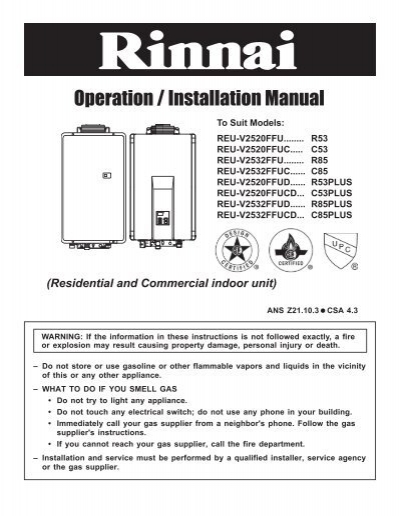12-Step Tankless Water Heater Flushing Procedure
Consult the manual provided by the tankless water heater manufacturer or contact the manufacturer directly for exact instructions regarding this procedure. In some cases, this procedure may require you to use a sump pump and connect hoses to discharge and flush water from the tankless water heater cold and hot water valves. Rinnai C85 Manuals Manuals and User Guides for Rinnai C85. We have 1 Rinnai C85 manual available for free PDF download. Rinnai C53; Rinnai CHS199100CU.
Over time, a tankless water heater may accumulate mineral build up which can erode the walls inside your tank's heating chamber. To properly maintain and clean your tankless water heater, it’s important to flush those mineral deposits at least once a year. Follow this simple process to ensure optimal tankless water heater performance and efficiency. Please read all of the instructions before beginning, as you’ll want to have all of the necessary supplies ready for the process.

You can also watch our Water Heater Flushing Procedure video on YouTube ─
1. Turn off the power source for your tankless water heater.
Rinnai C53 Manual Form
- Shut off the main gas or turn off the circuit breaker for electrical devices.
2. Close (turn off) the three water valves attached to your tankless water heater.

- This prevents cold water from flowing into the water heater and hot water from coming out during the cleaning process.
- The water valves consist of a cold water valve (colored blue), a hot water valve (colored red) and a main valve that runs the water into your home.
3. Remove the purge port valve caps slowly from the purge valves located on each of the cold and hot water valves.
- The purge valves have small handles that resemble the letter 'T.'
- This procedure is done to relieve any pressure that has built inside the valves and will prevent excess hot water from shooting out during the cleaning process.
- There may be pressure when removing the purge port valve caps, so it’s vital to confirm the hot water valve is completely shut off for your safety.
- Handle each cap carefully so the rubber sealing discs stay in place. These are needed for your valves to function properly.
4. Attach hosing lines to each of the three valves.
- If the manufacturer of your tankless water heater did not provide hosing lines, they are available at any home repair store that sells water heaters. The hosing lines must be long enough to reach between the water heater and a bucket.
- Consult the manual provided by the tankless water heater manufacturer or contact the manufacturer directly for exact instructions regarding this procedure.
- In some cases, this procedure may require you to use a sump pump and connect hoses to discharge and flush water from the tankless water heater cold and hot water valves.
5. Open the purge port valves by twisting them perpendicular to the position of the cold and hot valves.
6. Use 4 gallons (15.1 liters) of undiluted white vinegar to clean your tankless water heater. Never use chemical solutions of any kind.
- Since your home’s drinking and bathing water mostly likely flows through your tankless water heater, using chemical cleaning solutions could be extremely harmful to your health.
7. Follow the instructions included in your manufacturer’s manual to perform the flushing and draining procedure.
- This procedure may take up to 45 minutes.
8. Once the flushing process is complete, close the purge port valves by twisting the T-shaped handles.
9. Disconnect and remove the hosing lines from each valve.
Rinnai C53 Manual Transmission
10. Replace the purge port valve caps onto the purge valves.
- Tighten the caps completely and firmly. However, take care not to over-tighten or break the rubber sealing discs inside the caps.
11. Refer to the manufacturer's manual for exact instructions on how to safely restart your water heater.
- This may require you to rotate and open the cold and hot water valves so they are parallel to the position of the main valve.
12. Choose a sink tap inside and turn on the hot water slowly to allow the air to pass through the pipe.
- Continue to run the water until it runs steadily without air escaping (you may recognize this by a slight sputtering sound). .
- It may take to 2 or 3 minutes for all of the air pockets to escape.